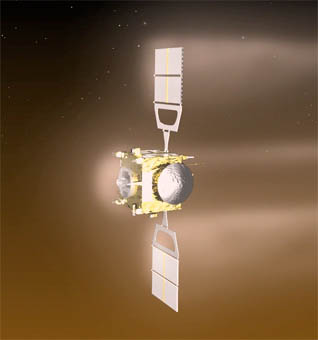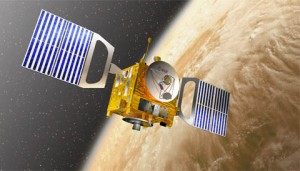A highly successful spacecraft has ended its mission after returning nearly a decade of data on Earth's nearest planetary neighbor.
Chances are good that you've never heard of an interplanetary spacecraft called Venus Express — and you wouldn't be alone. Launched by the European Space Agency in 2005, this spacecraft reached Venus in April 2006 and has been dependably sending back images, spectra, and other details about Earth's nearest planetary neighbor ever since.

ESA / C. Carreau
But the clock has finally run out on this dependable space sentinel. More accurately, the fuel ran out.
Six months ago ground controllers commanded the spacecraft to alter its elliptical orbit so that its periapsis, or low point, was no more than 135 km (85 miles) from Venus's surface. This dropped Venus Express into the planet's uppermost atmosphere once per day for several weeks in order to test out aerobraking techniques.
Then the periapsis altitude was raised, and limited scientific operations continued — though mission managers passed on the opportunity to observe Comet Jacques (C/2014 E2) when it passed just 8 million miles (13 million km) from Venus in mid-July. As the orbit continued to shrink due to gravitational perturbations, last month engineers commanded a last-ditch series of altitude-raising thruster firings that used up the last sips of fuel. Reliable radio contact was lost on November 28th, and ESA officials declared the mission over a week ago. The spacecraft is expected to plunge into the planet's atmosphere sometime in January.
Venus Express was designed to be a near clone of ESA's equally successful Mars Express: a 1-ton cube measuring about 5 feet (1½ m) on a side, with two long "wings" of solar-cell arrays for power. Although it carried a camera, Venus Express primarily studied the planet's dense, opaque atmosphere and the tenuous plasma higher up with a suite of six instruments and its radio transmitter.

ESA / D. Ducros
Most of the key findings came in the first two years of observations. For example, an assay of the atmosphere's deuterium-to-hydrogen (D:H) ratio confirms that eons ago Venus must have had substantial oceans. Lightning on Venus happens more often than it does on Earth, and there's a huge double vortex exists swirling over the planet's south pole.
Taken together, the spacecraft's observations led to the realization that Venus is even less Earth-like than previously thought.
Here's the website to learn more about this highly successful mission.
Check out the terrain on the hellish world next door with Sky & Telescope's exclusive Venus globe.
 1
1
Comments
George-Brewer
December 31, 2014 at 3:49 pm
Thanks to S&T, I've been following Venus Express at the ESA web site since it arrived. Since the updates slowed down dramatically over a year ago, I was unaware of the fuel situation. Good science.
You must be logged in to post a comment.
You must be logged in to post a comment.